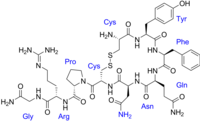
Photo from wikipedia
Hypovolemia induced by hemorrhage is a common clinical complication, which stimulates vasopressin (AVP) secretion by the neurohypophysis in order to retain body water and maintain blood pressure. To evaluate the… Click to show full abstract
Hypovolemia induced by hemorrhage is a common clinical complication, which stimulates vasopressin (AVP) secretion by the neurohypophysis in order to retain body water and maintain blood pressure. To evaluate the role of brain L-glutamate and angiotensin II on AVP secretion induced by hypovolemia we induced hemorrhage (∼25% of blood volume) after intracerebroventricular (icv) administration of AP5, NBQX, or losartan, which are NMDA, AMPA, and AT1 receptor antagonists, respectively. Hemorrhage significantly increased plasma AVP levels in all groups. The icv injection of AP5 did not change AVP secretion in response to hemorrhage. Conversely, icv administration of both NBQX and losartan significantly decreased plasma AVP levels after hemorrhage. Therefore, the blockade of AMPA and AT1 receptors impaired AVP secretion in response to hemorrhage, suggesting that L-glutamate and angiotensin II acted in these receptors to increase AVP secretion in response to hemorrhage-induced hypovolemia.
Journal Title: Brazilian Journal of Medical and Biological Research
Year Published: 2022
Link to full text (if available)
Share on Social Media: Sign Up to like & get
recommendations!